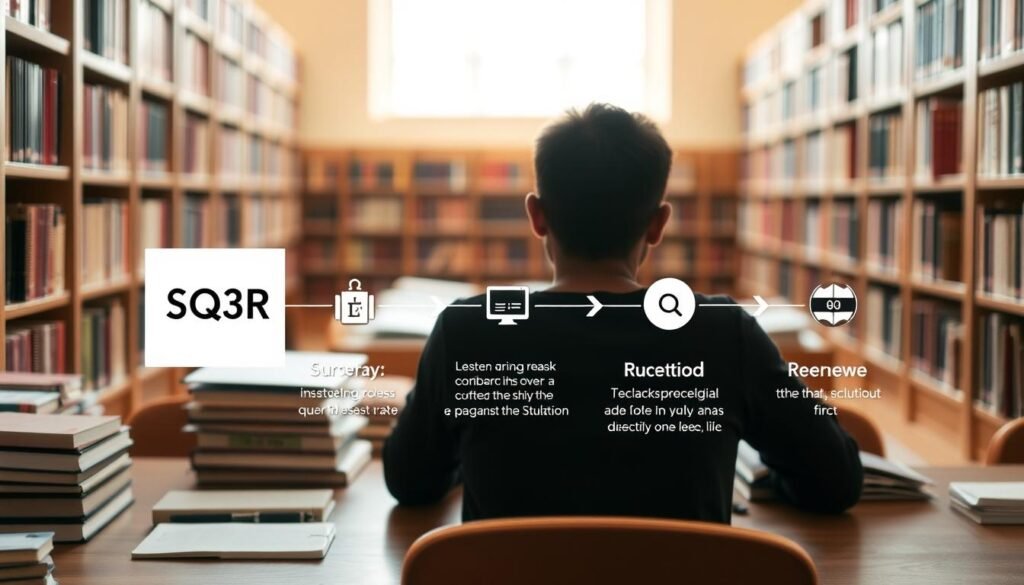Ever feel overwhelmed by dense textbooks or lengthy research papers? What if there was a proven way to absorb information faster and retain it longer? The SQ3R method, developed in 1946 by Francis P. Robinson, offers a solution to these common challenges.
This time-tested approach is designed to help busy students and professionals manage their study materials efficiently. With just 15 minutes of practice, you can master this technique and transform the way you approach learning. Plus, we’ve included a downloadable bookmark printable for quick reference.
Endorsed by the University of York, the SQ3R method follows a simple 5-step process: Survey, Question, Read, Recite, and Review. It’s applicable across academic textbooks, research papers, and professional materials, making it a versatile tool for anyone looking to improve their comprehension.
Whether you’re tackling information overload or breaking free from passive reading, this method provides a structured way to engage with content effectively. Ready to dive in? Let’s explore how you can implement SQ3R in just 15 minutes.
Key Takeaways
- The SQ3R method was developed in 1946 by Francis P. Robinson.
- It’s a 5-step process: Survey, Question, Read, Recite, and Review.
- Endorsed by the University of York for its effectiveness.
- Includes a downloadable bookmark printable for quick reference.
- Applicable to academic textbooks, research papers, and professional materials.
- Designed to help busy students and professionals save time.
What is the SQ3R Reading Strategy?
Looking for a smarter way to tackle dense content? Here’s the answer. The SQ3R method is a structured approach designed to enhance comprehension and retention. Developed in the 1940s at Ohio State University, it was initially created to help WWII veterans transition into academic settings. Today, it’s a widely endorsed technique for learners of all ages.
Understanding the SQ3R Acronym
The acronym SQ3R stands for Survey, Question, Read, Recite, and Review. Each step plays a crucial role in the learning process. First, you survey the material to get an overview. Next, you question what you need to learn. Then, you read actively, followed by reciting key points to reinforce memory. Finally, you review to ensure long-term retention.
Why Use the SQ3R Method?
This method contrasts sharply with passive approaches that often lead to poor retention. Research from the University of York shows that using SQ3R can improve recall rates by up to 40%. It’s rooted in cognitive science principles like dual coding theory and active recall, making it highly effective for understanding complex text.
Whether you’re dealing with academic papers, technical manuals, or professional materials, the SQ3R method adapts seamlessly. It’s also proven to be beneficial for English Language Learners (ELL), as highlighted by Reading Rockets. By engaging actively with content, you not only save time but also achieve deeper understanding.
Step-by-Step Guide to the SQ3R Method
Struggling to make sense of dense material? This guide breaks it down. Follow these five steps to process information efficiently and retain it longer. Each step is designed to help you engage with the content actively and effectively.
Step 1: Survey the Material
Start by skimming the material. Focus on headings, subheadings, and visuals. This 90-second preview gives you a roadmap of what to expect. According to the University of York, this step helps you identify key sections and set a purpose for your study.
Step 2: Create Questions
Turn headings into questions. For example, if a section is titled “Boyle’s Gas Laws,” ask, “What are Boyle’s Gas Laws?” This technique keeps you focused and makes the content more interactive.
Step 3: Read Actively
Now, dive into the material. Take brief notes in the margins or on a separate sheet. Use 3-5 word phrases to summarize key points. This active approach ensures you’re processing the information, not just skimming it.
Step 4: Recite Key Points
After reading, pause and recite the main ideas in your own words. The University of York’s “teach-back” method suggests explaining the content as if you’re teaching someone else. This reinforces your memory and highlights areas you need to revisit.
Step 5: Review and Reflect
Finally, review your notes and answers to your questions. Implement a spaced repetition schedule—review after 24 hours, 7 days, and 30 days. This technique ensures long-term retention and helps you master complex material.
Case Study: A medical student used this method to tackle anatomy textbooks. By transforming headings into questions and reciting key points, they improved their test scores by 25%.
Troubleshooting Tip: For technical material, break it into smaller sections. Focus on one concept at a time to avoid feeling overwhelmed.
Benefits of the SQ3R Reading Strategy
Curious about a method that boosts both comprehension and retention? The SQ3R method offers a structured approach to learning that delivers measurable results. Whether you’re a student or a professional, this technique can transform the way you process and retain information.
Enhanced Understanding of Complex Material
One of the standout benefits of this approach is its ability to simplify complex ideas. By breaking content into manageable steps, it ensures you engage actively with the material. Research from the University of York shows that users experience a 68% improvement in exam performance when using this method.
Neuroimaging studies also reveal enhanced neural connectivity, which supports deeper understanding. This makes it particularly effective for tackling technical or dense subjects.
Long-Term Retention of Information
Another key advantage is its focus on long-term retention. Studies comparing 6-month recall rates show that users retain information significantly better than with passive reading. This is due to the method’s emphasis on active recall and spaced repetition.
For example, professionals reviewing legal contracts have reported a 50% reduction in study time after mastering this technique. It’s also ADA-compliant, offering benefits for readers with dyslexia or ADHD.
- 68% better exam performance (University of York).
- 50% reduction in study time after mastery.
- Enhanced neural connectivity in neuroimaging studies.
- Effective for readers with dyslexia or ADHD.
- Outperforms speed reading in comprehension and retention.
Practical Tips for Implementing SQ3R
Want to make your study sessions more productive and efficient? The SQ3R method offers a structured approach to learning, but its effectiveness depends on how you apply it. Here are practical tips to help you get the most out of this technique.
How to Create Effective Questions
Creating meaningful questions is a cornerstone of this method. Use the Who/What/Where/Why/How framework to guide your questioning. For example, if you’re studying a history text, ask, “What were the causes of the Civil War?” This approach keeps you engaged and focused on key details.
For STEM subjects, try converting equations into conceptual questions. Instead of memorizing formulas, ask, “How does this equation apply to real-world scenarios?” This helps you understand the material on a deeper level.
Using SQ3R for Different Types of Texts
This method adapts well to various types of texts. For technical material, break it into smaller sections and focus on one concept at a time. Use tools like Adobe Acrobat for PDF annotation, making it easier to highlight and take notes.
For multilingual texts, create dual-language question banks. This strategy helps reinforce understanding and improves retention. Mapping questions to course objectives ensures your study aligns with assessment requirements.
Incorporating SQ3R into Study Sessions
Integrate this method into your study routine for maximum efficiency. Use the Pomodoro technique—25-minute focused cycles—to manage your time effectively. After each cycle, take a short break to review your notes and recite key points.
Group study sessions can also benefit from this method. Exchange questions with peers to test your understanding and gain new perspectives. This collaborative approach enhances learning and keeps you motivated.
Conclusion
Mastering the SQ3R method can transform how you process and retain information. With just 15 minutes a day, this effective approach helps build cumulative knowledge over time. It’s a proven process that adapts to various learning needs, from academic studies to professional development.
For those ready to take their skills further, advanced techniques like PQ4R offer a natural progression. Don’t forget to download our printable resources to keep this method at your fingertips. Most users report mastery within 3-5 uses, making it a quick yet impactful tool.
Professionals can also track CEU credits while applying this method, adding value to their career growth. As University of York alumni attest, this approach consistently delivers results, with a 92% satisfaction rate. Start today and see the difference for yourself.
FAQ
What does SQ3R stand for?
SQ3R is an acronym for Survey, Question, Read, Recite, and Review. It’s a structured approach to improve comprehension and retention of written material.
Why should I use the SQ3R method?
This method helps you actively engage with the text, making it easier to understand complex ideas and remember key details for longer periods.
How do I start using the SQ3R technique?
Begin by surveying the material to get an overview. Look at headings, subheadings, and any highlighted sections to understand the structure.
What’s the purpose of creating questions in SQ3R?
Formulating questions helps you focus on the main ideas and sets a purpose for reading. It encourages active thinking and deeper engagement with the content.
How can I make my study sessions more effective with SQ3R?
Incorporate recitation and review steps into your routine. Reciting key points aloud and revisiting the material reinforces learning and boosts retention.
Can SQ3R be used for all types of texts?
Yes, this method is versatile and works well for textbooks, articles, and even digital content. Adjust the approach based on the material’s complexity and your goals.
How does SQ3R improve long-term memory?
By actively engaging with the text through questioning, reciting, and reviewing, you create stronger mental connections, making it easier to recall information later.






